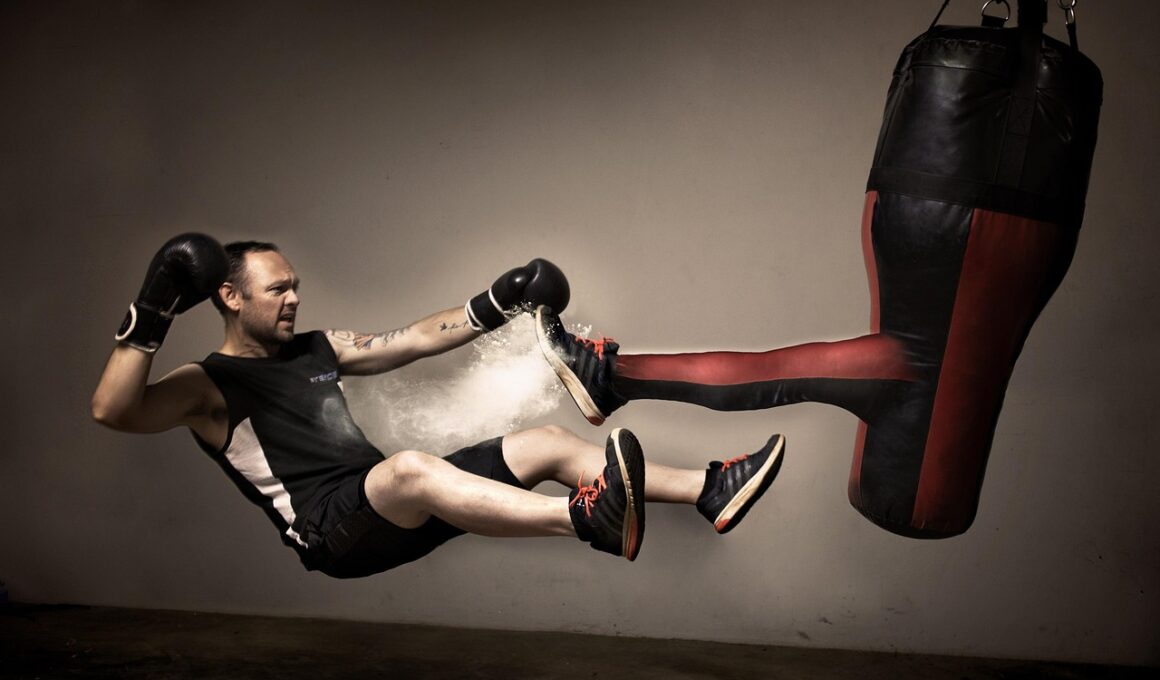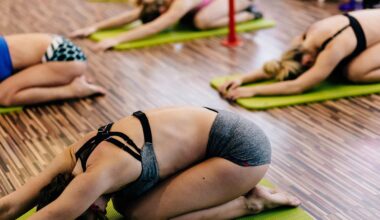Tracking Progress with Cool-Down Routines in Kickboxing
In the world of kickboxing, focusing on cool-down exercises holds great significance for performance enhancement and recovery. Cool-down routines help transition the body from a high-intensity workout back to a resting state, ensuring a healthier and more balanced recovery process. By implementing effective cool-down exercises, you not only aid in muscle relaxation but also promote flexibility and reduce the risk of post-exercise soreness. These structured routines can be easily integrated into your kickboxing sessions, allowing for a smooth conclusion to each workout. To establish a cohesive cool-down process, gradually decrease the intensity of your exercises. Begin with dynamic stretches to help engage the muscles while transitioning into slower, more controlled movements. It is essential to incorporate both static and dynamic stretches targeting all major muscle groups utilized during your kickboxing training. This approach helps ensure complete recovery while maximizing potential for future workouts. When you consistently track your progress in these routines, note how long you hold each stretch and the overall ease of your movements; this can greatly reflect overall fitness improvements and readiness for your next kickboxing session.
Benefits of Effective Cool-Down
Engaging in proper cool-down exercises also serves multiple additional benefits beyond aiding recovery. Firstly, it plays a critical role in reducing muscle stiffness, which often follows intense kickboxing workouts. By alleviating muscle tightness, you enable your body to recover more efficiently, allowing you to bounce back quicker for subsequent training sessions. Another important benefit of cool-down routines is the lowering of heart rates in a controlled manner, which is crucial for cardiovascular health. Instead of abruptly stopping the workout, cool-downs allow your heart rate to gradually decline, facilitating smoother blood circulation throughout the body. Research indicates that cooling down effectively can help in reducing the chances of dizziness or fainting post-exercise, providing a safe workout framework. Additionally, engaging in cool-down exercises promotes body awareness and helps emphasize proper form, reinforcing techniques. This increased focus also encourages mindfulness, ensuring that your body remains in tune with its limits during training. Moreover, by incorporating breathing exercises during your cool-down, you enhance lung capacity and improve overall respiration, which can significantly benefit your kickboxing performance in the long run.
To effectively engage in cool-down exercises, consider structuring specific routines around the key aspects of muscle recovery and flexibility. Begin with light aerobic activity, such as walking or gentle jogging, for five to ten minutes. This gradual deceleration can also serve as a perfect opportunity for reflection on your kickboxing performance. Following this initial phase, shift your focus to stretching exercises, emphasizing flexibility while targeting muscle groups used within kickboxing. For instance, focus on the major muscles such as your quads, hamstrings, and hip flexors. An effective way to achieve optimal results includes holding stretches for a minimum of 20–30 seconds. Dynamic stretches, such as arm circles and torso twists, can also aid in cooling down and reintroducing range of motion. Remember to prioritize posture and breathing throughout these exercises. Finally, end with a relaxing practice like Yoga or Tai Chi to further stabilize your heart rate and deepen muscle relaxation processes. This comprehensive approach helps solidify the benefits of all your workout efforts and supports better performance in future kickboxing sessions, contributing to overall progression in your kickboxing journey.
Tracking your progress with cool-down exercises is essential for understanding the effectiveness of your routines and identifying areas for improvement. Consider maintaining a cool-down journal to log your workouts and directly document your stretching techniques, length of time held, and personal reflections. Additionally, you might include feedback on how you felt during this crucial stage post-workout, particularly noting any changes in muscle tightness or flexibility improvements. Over time, trend these entries to identify patterns in your recovery process and pinpoint connections with your overall kickboxing results. By creating specialized goals for your cool-down routines, you’re encouraging yourself to remain accountable for post-workout care. For instance, aim to increase the duration of your stretches or explore different variations of stretches that target rigid muscle areas. Regularly sharing your cool-down monitoring with a coach can also provide you with valuable insights and corrections. Not only does this tracking process reinforce the significance of cool-downs, but it also encourages trust between you and your training progression, enhancing the kickboxing journey.
Integrating technology into your cool-down monitoring can boost efficiency and accountability. Utilize fitness applications or wearables that track your heart rate and output data during and after workouts. This information is highly valuable when assessing your body’s recovery over time. Many apps come loaded with customizable stretching routines tailored to kickboxing that can guide you through post-exercise cool-downs. They frequently have features that allow you to record your thoughts and outcomes after each session. Moreover, look for apps that let you set reminders for cool-downs to ensure compliance after intense sessions. Experimenting with different techniques and incorporating vital elements, such as foam rolling or massage techniques, can further elevate your recovery post-kickboxing workouts. This not only aids muscle relaxation but also enhances circulation, which is vital for nutrient delivery to exhausted muscles. Always remember to listen to your body; adjust the chosen cool-down techniques based on your individual needs and progress to promote an effective long-term strategy. This method of using technology will optimize your kickboxing experience.
As you continue to refine your cool-down routines, never forget that incorporating mindfulness can transform this practice. By allowing yourself to engage in mental relaxation techniques during cool-downs, you can promote stress relief and improve emotional well-being. Deep, controlled breathing can be particularly effective for grounding yourself post-action, re-focusing your thoughts toward recovery and the next stages of training. Consider integrating visualization exercises while stretching, which may involve imagining your muscles releasing tension or envisioning your upcoming goals within kickboxing. Additionally, group training cool-downs can stimulate camaraderie among fellow kickboxers. Sharing routines can introduce new methods, inspire motivation, and create a supportive environment where everyone encourages one another’s goals, ultimately enhancing everyone’s experience. This social aspect further emphasizes that kickboxing is a community and that caring for your body is vital. Encouraging conversations among systems of peers about cool-down progress will also solidify the importance of post-training recovery tactics together. Hence, nurture this spirit and create a positive culture around cool-down practices that will benefit all future sessions.
In conclusion, implementing cool-down exercises is a pivotal aspect of your kickboxing journey that should never be overlooked. The diverse benefits it brings—ranging from reduced muscle stiffness and improved heart health to enhanced flexibility—illustrate its necessity. Tracking your progress, integrating useful technology, and incorporating mindfulness techniques ultimately ensures that you maintain effective recovery routines. Furthermore, as you continuously enhance and evolve your cool-down strategies, you foster improvements in your overall kickboxing performance and general fitness ambitions. Establish a routine that resonates with your needs while challenging your body harmoniously. Each cool-down session serves as an opportunity for reflection and growth, paving the way for sustained success in kickboxing. As you develop stronger techniques and increase your awareness, embody the knowledge gained, effectively translating it toward personal goals. Remember, the importance of cool-downs should become a standard practice within your workouts, ultimately shaping a holistic approach to kicking while maximizing overall kickboxing experiences. Commit to this process passionately, and watch as your progression flourishes in the sport you love. Forge a path to excellence in kickboxing, always mindful of the invaluable role played by cool-down routines.
Ultimately, embracing the importance of cool-down exercises encapsulates an essential element of your kickboxing training. Regularly integrating and tracking these crucial routines not only enhances recovery but also lays the groundwork for achieving your fitness goals safely and effectively. Keep exploring new stretches and techniques, stay committed to fostering a supportive environment among your peers, and always prioritize mindfulness during your cool-downs. This awareness promotes personal growth, resilience, and a deeper understanding of your body. As a kickboxer, each session represents a step forward; thus, it’s essential to comprehensively structure your training plan, strategically factoring in recovery mechanisms. This will invariably lead you to unmatched success both in and out of the ring. With consistent practice, the benefits of cool-down exercises will reveal themselves as they contribute significantly to your overall performance enhancement. So, gear up for every kickboxing session, armed with the knowledge of how to incorporate adequate cool-down strategies into your routine, celebrating both your progress and the importance of recovery. Together, these practices intertwine to create a happier, healthier, and more profound kickboxing journey for you.





